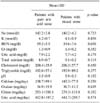Abstract
Purpose
We investigated the biochemical characteristics of serum and urine in the patients suffering with uric acid stone.
Materials and Methods
A total of 99 patients suffering with uric acid stone underwent routine urine analysis and 24-hour urine analysis for determining the urinary calculi risk factors. We conducted serum analysis for the stone risk factors and also analysis of the stone analysis. To compare the stone risk factors, 93 patients with calcium stone were identified and then the biochemical risk factors in the serum and urine were evaluated.
Results
The mean age of patients with uric acid stone was 56.5±12.4 years and the mean age of the patients with calcium stone was 40.2±11.5 years. Serum uric acid, cholesterol and triglyceride were all significantly increased in the patients with uric acid stone compared to that in the patients with calcium stone. The patients with uric acid stone showed a lower urinary pH and also lower urinary uric acid and citric acid excretion compared with those patients with calcium stone. The composition of the uric acid stone was mixed with calcium in 63.6 percent of the stones and 36.4% of the stones were pure.
Conclusions
The patients with uric acid stone had higher serum uric acid, cholesterol and triglyceride, and they had a lower urinary pH and lower uric acid and citric acid excretion as compared with the patients with calcium stone. Uric acid-calcium mixed stone was most common in the patients with uric acid stone. There is a great likelihood of uric acid stone in the patients with stone who have one or more of the above mentioned biochemical characteristics. Therefore, these factors are important to conduct metabolic evaluation for preventing stone recurrence.
Figures and Tables
Table 1
Comparison of biochemical stone risk factors in serum between patients with uric acid stone and patients with calcium stone

References
1. Goldfarb DS, Coe FL. Prevention of recurrent nephrolithiasis. Am Fam Physician. 1999. 60:2269–2276.
2. Yu T, Gutman AB. Uric acid nephrolithiasis in gout. Predisposing factors. Ann Intern Med. 1967. 67:1133–1134.
3. Uhlir K. The peroral dissolution of renal calculi. J Urol. 1970. 104:239–247.
4. Pak CY, Moe OW, Sakhaee K, Peterson RD, Poindexter JR. Physicochemical metabolic characteristics for calcium oxalate stone formation in patients with gouty diathesis. J Urol. 2005. 173:1606–1609.
5. Pak CY, Holt K. Nucleation and growth of brushite and calcium oxalate in urine of stone-formers. Metabolism. 1976. 25:665–673.
6. Gutman AB, Yu TF. Uric acid nephrolithiasis. Am J Med. 1968. 45:756–779.
7. Hesse A, Schneider HJ, Berg W, Hienzsch E. Uric acid dihydrate as urinary calculus component. Invest Urol. 1975. 12:405–409.
8. Scholz D, Schwille PO, Ulbrich D, Bausch WM, Sigel A. Composition of renal stones and their frequency in a stone clinic: relationship to parameters of mineral metabolism in serum and urine. Urol Res. 1979. 7:161–170.
9. Grenabo L, Hedelin H, Pettersson S. The severity of infection stones compared to other stones in the upper urinary tract. Scand J Urol Nephrol. 1985. 19:285–289.
10. Balaji KC, Menon M. Mechanism of stone formation. Urol Clin North Am. 1997. 24:1–11.
11. Wasko R, Frankenfield BA. Allopurinol dissolution of renal uric acid calculi. JAMA. 1968. 205:801.
12. Lewis RW, Roth JK Jr, Polanco EJ, Roberts JA. Molar lactate in the management of uric acid renal obstruction. J Urol. 1981. 125:87–90.
13. Coe FL. Uric acid and calcium oxalate nephrolithiasis. Kidney Int. 1983. 24:392–403.
14. Coe FL, Evan A, Worcester E. Kidney stone disease. J Clin Invest. 2005. 115:2598–2608.
15. Abate N, Chandalia M, Cabo-Chan AV Jr, Moe OW, Sakhaee K. The metabolic syndrome and uric acid nephrolithiasis: novel features of renal manifestation of insulin resistance. Kidney Int. 2004. 65:386–392.
16. Maalouf NM, Sakhaee K, Parks JH, Coe FL, Adams-Huet B, Pak CY. Association of urinary pH with body weight in nephrolithiasis. Kidney Int. 2004. 65:1422–1425.
17. Matzkies F, Berg G. The uricosuric action of amino acids in man. Adv Exp Med Biol. 1977. 76:36–40.
18. Ito H, Kotake T, Nomura K, Masai M. Clinical and biochemical features of uric acid nephrolithiasis. Eur Urol. 1995. 27:324–328.
19. Stoller ML. Gout and stones or stones and gout? J Urol. 1995. 154:1670.
20. Pak CY, Sakhaee K, Peterson RD, Poindexter JR, Frawley WH. Biochemical profile of idiopathic uric acid nephrolithiasis. Kidney Int. 2001. 60:757–761.
21. Khatchadourian J, Preminger GM, Whitson PA, Adams-Huet B, Pak CY. Clinical and biochemical presentation of gouty diathesis: comparison of uric acid versus pure calcium stone formation. J Urol. 1995. 154:1665–1669.
22. Shekarriz B, Stoller ML. Uric acid nephrolithiasis: current concepts and controversies. J Urol. 2002. 168:1307–1314.
23. Choi MS, Jung GW, Sung GT. Biochemical and clinical comparison of gouty diathesis with uric acid and calcium stone. Korean J Urol. 1998. 39:537–541.
24. Bichler KH, Strohmaier WL, Schanz F, Nelde HJ, Gaiser I, Schulze E, et al. Effect of calcium antagonists (nifedipine) on nephrocalcinosis and calcium excretion in the rat. Urol Int. 1985. 40:13–21.
25. Moriwaki Y, Yamamoto T, Takahashi S, Tsutsumi Z, Higashino K. Apolipoprotein E phenotypes in patients with gout: relation with hypertriglyceridaemia. Ann Rheum Dis. 1995. 54:351–354.
26. Kim YH, Lee NK, Park YH. Medical treatment for uric acid calculi. Korean J Urol. 1995. 36:736–743.
27. Ferrari P, Bonny O. Diagnosis and prevention of uric acid stones. Ther Umsch. 2004. 61:571–574.
28. Pak CH, Oleneva VA, Agadzhanov SA. Dietetic aspects of preventing urolithiasis in patients with gout and uric acid diathesis. Vopr Pitan. 1985. 1:21–24.
29. Jeong YB, Kim YG, Hwang TK, Kim DS, Lee JZ, Kim HH, et al. The physiologic effects of the urocitra in patients with urolithiasis. Korean J Urol. 2002. 43:468–473.




 PDF
PDF ePub
ePub Citation
Citation Print
Print




 XML Download
XML Download